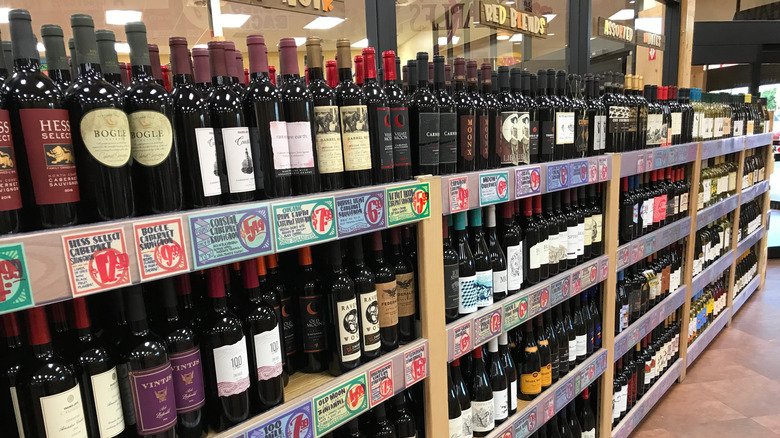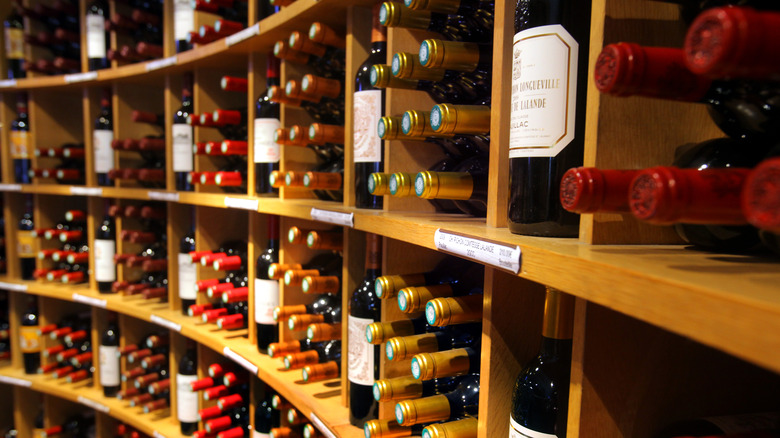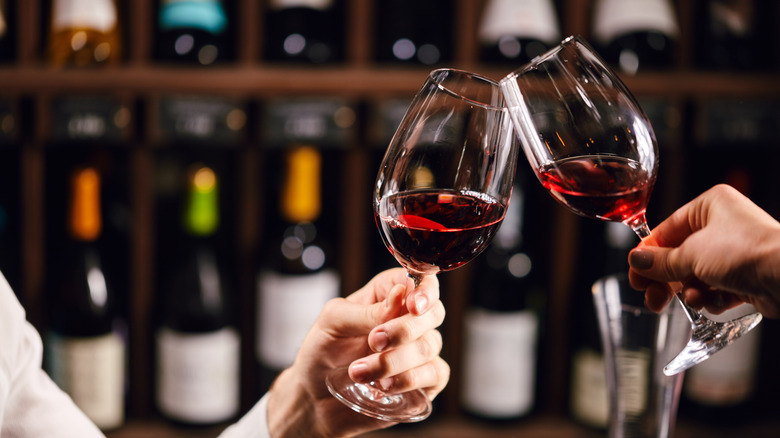Why You Should Think Twice About Buying Wine At The Grocery Store
People are busy and convenience is key when it comes to stocking the kitchen with fresh food and beverages. Many people like one-stop shopping when it comes to groceries, home goods, office supplies, attire, cosmetics, pet supplies, and adult beverages. In many states, superstores like Target, Walmart, and Costco have vast grocery and beverage aisles with big brands and low prices. Trader Joe's is famous for its value-oriented wine selection.
Sometimes, you can find hidden wine gems while sifting through their selections. If you know what you like and what you are looking for, grocery store wine shopping can be great. Grocery store wine selections are convenient if you are cooking with wine and need something simple for your recipe. When you are new to wine, shopping in grocery store wine departments can be overwhelming and intimidating because the shelves are stacked high and packed with dozens of wine brands from around the country and the world. Where do you begin?
For the newly wine-curious, purchasing wine in grocery stores might not be your best bet. In fact, it might not even be legal where you live. According to HuffPost, not all states allow for wine sales in grocery stores. They recently reported that only 36 states do. But for those wine drinkers who can buy wine in grocery stores, there are pros and cons to doing so, and some may surprise you.
Boutique wine shops aim for quality and selection
Most of the wine in grocery stores is produced and sold by enormous adult beverage conglomerates with an eye on quantity and not necessarily quality. These mass-produced wines can be perfectly fine to drink, and often represent the region from which it came and the grapes from which it is produced. However, they may not be exceptional.
Wines on grocery store shelves aren't kept in the best condition. They stand upright, which dries out the cork if there is one. The harsh fluorescent light degrades flavors and aromas. The temperatures are often higher than ideal for wine storage. The bottles may linger on the shelves for months or even years until the wine is bad or past its prime.
Boutique wine shops and large wine and spirit stores are designed with wine in mind. Wines are stored on their sides, in properly lit, temperature-controlled rooms. Wine stores arrange their wine selections by style, country, or region. Wine regions determine the grapes and style of wine in the bottle. High-end wine stores will have deep libraries of top-selling wines from Italy, France, Spain, and the USA, along with sparkling wines, and champagne.
Shopping in wine stores can be as intimidating as grocery store wine departments because the shelves are stuffed with brands that may have a dozen types of wine under one label, or labels are in an entirely different language. How do you know what to pick?
Wine boutiques have trained staff to assist you
Wine shops attract wine-passionate people. They pride themselves on employing engaging staff with abundant wine-focused training and credentials, who are able to best serve their clients. Sommeliers earn wine knowledge through rigorous study and testing with organizations like the Wine & Spirits Education Trust (WSET), the International Sommelier Guild (ISG), and the Court of Master Sommeliers (CMS). Wine students and professional wine sommeliers enjoy studying wine and love to share what they know with anyone who will listen. Befriend them.
When you are just starting out on your wine journey, these wine shop sommeliers are there to help you. They will ask questions and listen to your answers to hone in on wine styles you will enjoy. Over time, they will help build your knowledge by finding similar wines from different producers, regions, and countries for you to try. Through these conversations, they will help you develop a collection of wines that you can go to over and over again.
Not only do wine shop sommeliers know about wine from all over the world, but they also excel at creating interesting wine and food pairings, which is the point of drinking wine anyway. Wine blossoms with the right food pairing, making each taste better.
Make a list and stick to it to focus your shopping
Historically, wine has always been consumed as an accompaniment to food. In fact, in Europe, wine was so important to meals that it was quaintly known as sauce. The colloquialism "to get sauced" (read: drunk) came from this thinking, according to "The Story of Wine" by wine expert Hugh Johnson. If you always grocery shop with a list to ensure everything you need makes it into your shopping basket, do the same thing with wine. Tell your new wine shop sommelier friend about your planned menu and let them help with a perfect food and wine pairing. Once they learn your taste, they will be able to find the right wine for you for every occasion.
The bottom line when it comes to buying wine: In the beginning, get free expert advice when you can. Attend in-store tastings if your state permits them. Build a relationship with your local store sommelier. Keep a journal of what you like and what you don't. There are apps for that. Check out Cellar Tracker and Vivino to catalogue your budding wine collection and your tasting notes. These interactive apps allow you to communicate with wine lovers across the globe.
The most important thing to remember about wine is that it is simply fermented grape juice and exploring wine is the fun part, even when we make mistakes or buy bad bottles. Your tastes will change along the way. It is the experience that you savor when you sip that matters.



